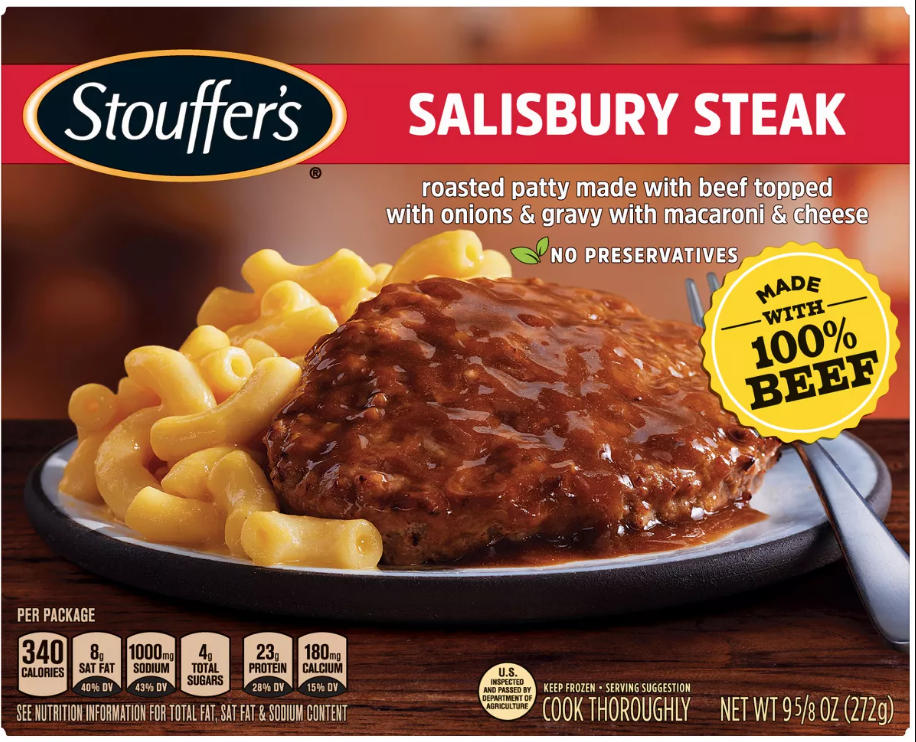The Historic Connection Between TV Dinners and Diarrhea?
Pictured above is a TV dinner — a meal you make by opening a box of already-cooked food and microwaving it for a few minutes. You can find them in the freezer section of most grocery stores in America and beyond. And if you go looking for them, there’s a very good chance you’ll see a Salisbury steak option like the one above. Not only does Stouffer’s, as seen above, make one, but so do Marie Callender’s, Hungry-Man, Banquet, and On-Cor.
And it’s all because, 160 years ago, a doctor named James Salisbury tried to save lives — and got everything totally backward.
If you’re unfamiliar with Salisbury steak, it’s simply ground meat (and sometimes other additives like ground vegetables and seasonings) reformed in the shape of steak-like patties smothered in gravy. That makes it a perfect choice for TV dinners — manufacturers can standardize the portion size and maintain consistency throughout the produce line, and as a result, ensure that customers can’t really mess it up if they follow the microwaving (or if you have the time, oven baking) instructions on the box. As it’s precooked, all the consumer has to do is reheat and eat.
The convenience of such a meal wasn’t the original intention, though (although it probably helped). When James Salisbury created his namesake meal in the early 1860s, he was serving as a physician in the American Civil War, and he was looking for a way to save soldiers’ lives. And he thought he had a solution. The muskets and bayonets of opposing soldiers weren’t the leading cause of death during the War — not even close. As PBS explains, “Of the 620,000 recorded military deaths in the Civil War about two-thirds died from disease.” Topping the list of fatal diseases were diarrhea and dysentery (which were treated as one and the same). Per NPR affiliate WVTF, “Among the 2,000,000 men who served in the Union armies, there were 1,900,000 reported cases of diarrhea and dysentery. How many tens of thousands of others suffered in silence can never be known.”
The rampant diarrhea during the Civil War had many causes and wasn’t well understood at the time. But doctors of the era took the simplest path toward a solution, one which was directionally correct: soldiers had very poor diets, and medical professionals could help alleviate intestinal discomfort by changing through medication as well as by changing what soldiers were eating and drinking. In the former case, the solution often made the problem worse; as WVTF reported, “favorite ‘medications’ were whiskey as well as such purgatives as turpentine and castor oil, which, of course, further inflamed the intestinal tract.” Salisbury, though, focused on the latter, wondering if we could stave off diarrhea but adjusting the diets of those in uniform.
His theory was simple, as described by the Bratenhal (Ohio) Historical Society: “He believed that vegetables produced poisonous toxins in the digestive system were responsible for heart disease, tumors, mental illness, and tuberculosis. He believed that humans were meant to eat meat and sought to limit vegetables, fruit, starches, and fat to the diet.” So he came up with a heat-and-eat solution: broiled cakes of ground lean beef, delivered to the soldiers as rations.
Salisbury’s steaks proved popular enough among the troops that it stuck as a part of American cuisine. It did not, however, help address the diarrhea problem — as we know today, a diet of ground beef and gravy — and no vegetables — is a bad, bad way to better health.
Bonus fact: Not only did Salisbury’s solution not work, it likely made the diarrhea problem worse. One of the main drivers of intestinal discomfort among Civil War soldiers was scurvy, a condition caused by a lack of vitamin C. Soldiers weren’t getting enough vitamin C because they weren’t eating enough vegetables: As the National Museum of Civil War Medicine explains, getting fresh vegetables to the boys in the field was virtually impossible, so (for the Union, but a similar story is true for the Confederacy), “Congress passed a law providing for the creation of canned, compressed, and mixed vegetables called desiccated vegetables. The rations of desiccated vegetables supposedly contained string beans, turnips, carrots, beets, and onions which had been compressed into one-inch by one-foot rectangular bricks.” The desiccation process probably made the vegetables ineffective against scurvy, as it the vitamin density of the vegetables plummeted as the vegetables were cooked and processed. And it probably didn’t matter anyway, per the Museum, “Soldiers would often refuse to eat the desiccated vegetables because they tasted so dreadful.”
From the Archives: The Last Civil War Checks: As in, payments to soldiers.

